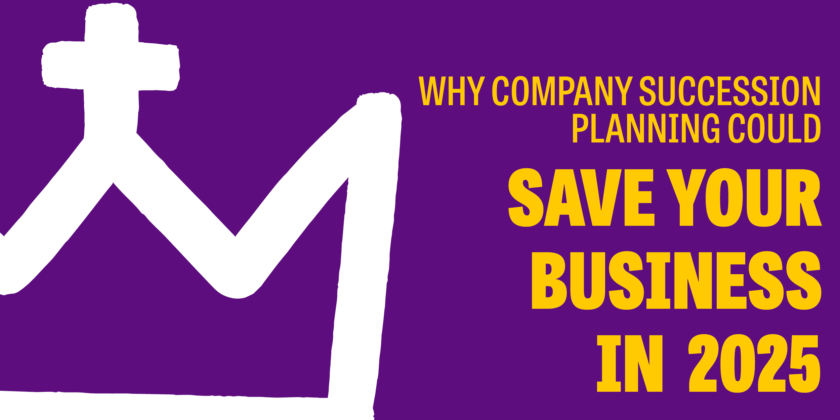Imagine this: your top-performing director hands in their notice. No warning. No back-up plan. Suddenly, the team is directionless, projects stall, and clients feel the wobble. HR scrambles. Senior leaders panic. Morale dips. Sound familiar?
It’s a scenario that plays out more often than anyone would like to admit. It’s not that organisations don’t have talent, it’s that they haven’t planned for continuity. When key people leave, the absence of a clear plan slows momentum and puts pressure on the whole system.
Right now, succession planning is one of the most undervalued tools in the HR toolkit. Too often, it’s only triggered by fear, when someone resigns or retires. But what if it could be driven by possibility instead? What if succession planning became the way we build capability, nurture potential, and grow the leaders we need tomorrow – starting today?
At Let’s Talk Talent, we believe everyone has potential. But the real question is: potential for what? That’s where succession planning becomes not just an HR process, but a strategic lever for business growth. Not a safety net for exits, but a runway for ambition.
The growth problem hiding in plain sight
We hear it all the time: “Succession planning is a priority.” According to Korn Ferry, less than 1 in 4 companies believe they have a strong succession plan and almost 50% are more dependent on outside hires than internal succession.
That disconnect? It’s costing businesses dearly.
It means missed opportunities to stretch talent. It means bench strength gaps when change hits. It means losing your future leaders to other companies that have clearer career pathways.
We’ve seen succession planning unlock extraordinary clarity, not just about who could step into key roles, but about how to align development, ambition, and business need. It shifts the conversation from contingency to capability. From panic to possibility.
Succession planning = untapped growth
Let’s stop thinking about succession planning as risk mitigation and start seeing it for what it is: one of the most powerful growth strategies an organisation has.
It allows you to:
- Retain great people by giving them visibility over their future.
- Build stronger, more agile teams through intentional development.
- Align personal growth with business continuity.
A recent Pew Research study found that lack of advancement opportunities was one of the top reasons employees left their roles. Succession planning changes that. It gives people direction. It shows them you see them, not just for who they are now, but for who they could become.
Our belief: everyone has talent
We don’t believe in static labels. We believe in potential. The key is understanding what kind of potential someone has, and what support they need to fulfil it.
That’s why at Let’s Talk Talent, we use a simple but powerful succession planning framework:
- Highly regarded specialists: Brilliant in-role performers who deliver excellence every day.
- Future leaders: People with the ambition, agility, and traits to take on bigger, broader challenges.
- The talented many: Individuals with untapped potential, often hidden in plain sight.
This isn’t just about who takes over the big roles. It’s about building momentum across the whole organisation. It’s about knowing who’s ready for what, and helping them get there.
What gets in the way?
Of course, if it were easy, everyone would be doing it well. But most organisations run into the same familiar blockers that stall progress and dilute impact.
If you’re struggling to get succession planning off the ground, you’re not alone. In fact, we’ve written a whole piece on The 7 Most Common Succession Planning Mistakes to Avoid. Here are some of the biggest hurdles:
- It’s too focused on senior roles
- It’s shrouded in secrecy, causing confusion or mistrust
- Managers aren’t confident having career conversations
- It’s reactive, not proactive
What ties these together is a mindset: treating succession as a static, confidential process owned by HR alone. The shift comes when you embed it into your leadership culture, as something transparent, empowering, and owned by everyone.
The good news? These are all fixable. With the right mindset and the right tools, succession planning becomes not only doable, but transformative.
Succession planning is a leadership responsibility
And here’s where the real shift happens.
When succession planning is done well, it’s not seen as a one-off exercise or an HR spreadsheet, it’s embedded in how leaders think, how they coach, and how they grow their teams.
Succession planning should be fully integrated with your wider career development efforts. That means regular, meaningful conversations about growth, not just annual reviews. It means building clarity around potential career pathways. It means helping your people understand how their ambitions align with the needs of the organisation.
When managers are equipped to spot potential, challenge performance, and provide development opportunities, they become catalysts for long-term talent growth. It’s also a retention strategy. When people see a pathway forward, they feel seen. They feel valued. And they’re far more likely to stay and stretch.
It’s not just HR’s job to care about the future of your people. Great leadership means growing others. And succession planning should be a strategic conversation across the business.
Because when your people see a path forward, they don’t just stay. They step up.
Final thought: succession is about building, not replacing
If you’re only thinking about succession when someone resigns, you’re already behind.
When you reframe succession planning as a growth lever, a way to spark ambition, develop capability and retain your best people, you create a stronger, more resilient organisation.
It’s not about planning for absence. It’s about preparing for progress.
Want to go deeper? Download our Succession Planning Whitepaper for insights on how we approach Talent and Succession planning.
If you’re ready to do the work and start planning for the future, today, get in touch to explore how we can help you future-proof your Talent Management strategy.
